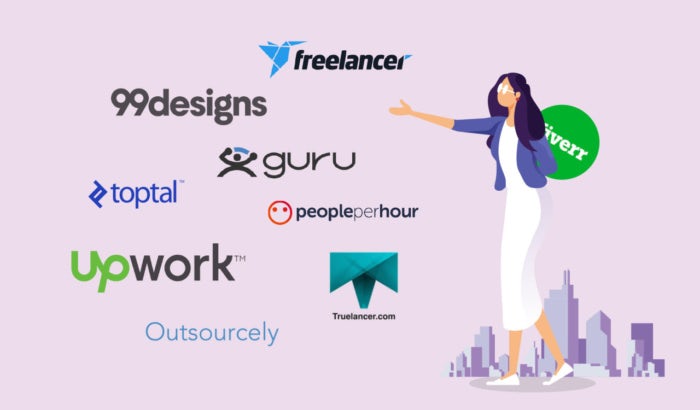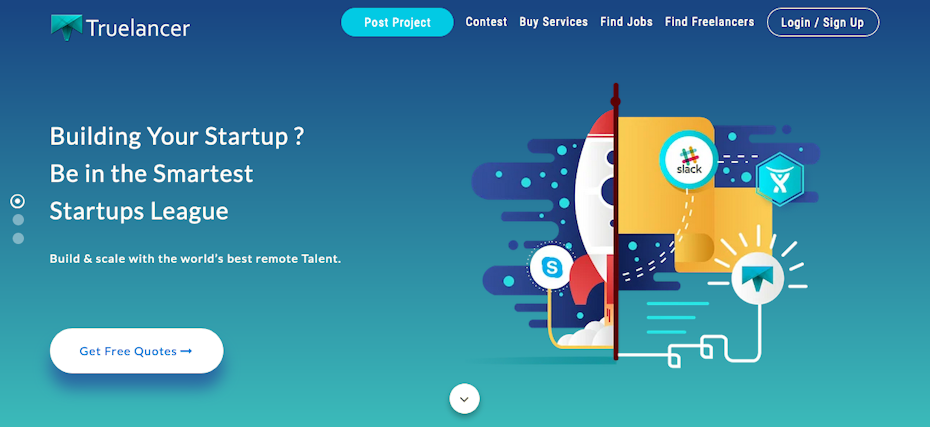Businesses and freelancers alike use Fiverr because of its large, competitive community and low-cost work. But for both freelancers and businesses, there is a wide range of Fiverr alternatives out there, including platforms that are more specialized, offer more security, higher quality and more flexibility. Which one is right for you depends entirely on your needs and wants.

We’ve compiled the 8 best alternatives to Fiverr along with the pros and cons of each—both for businesses commissioning work and for freelancers searching for work.
The 8 best Fiverr alternatives are:
—
1. Upwork
With a broad range of services and a longstanding reputation, Upwork is often the first platform that comes up when discussing Fiverr alternatives. Upwork is like an upscale version of Fiverr. It’s an open marketplace for posting jobs and connecting with freelancers that offers more safety regulations for payment exchanges and more professional standards.

Upwork vs. Fiverr
The biggest difference between Upwork and Fiverr is the bidding system. On Fiverr, freelancers post their price and businesses find the one that fits their budget. On Upwork, businesses post their jobs and freelancers post their bids. In some cases, you may get design work for cheaper than elsewhere. However, don’t expect freelancers to undercut themselves too much; quality freelancers don’t need to get into a bidding war.
For freelancers
Upwork is a general marketplace for all types of services: logo design, software development, even structural engineering, to name a few. They have a community of designers, but the site itself doesn’t specialize in graphic design or branding. While the fact that they’re one of the biggest freelance marketplaces might be attractive to designers, all that site traffic doesn’t translate to just design work.
For businesses
For better or worse, the search process in Upwork is very detailed, precise and focused. You can really fine-tune your searches and hone-in on particulars, but the process itself can be daunting and time-consuming. Prices and quality vary, and Upwork has a little representation of all degrees on the spectrum. If you’re sensitive about pricing, you might like Upwork’s bidding system, where businesses post their target price.
2. 99designs
The best Fiverr alternative when it comes to graphic design is 99designs. Although we may not be able to beat Fiverr’s extremely low single-digit price tags, we make up for it with design quality. Hosting the biggest, most diverse, and most talented designer community around the world, 99designs has one, singular focus: graphic design and only graphic design.

99designs vs. Fiverr
As we explained in our 99designs vs. Fiverr guide, Fiverr typically offers lower prices, so if cost is your top priority, you might like the options in Fiverr better. 99designs takes a different strategy with design contest and project options that offer higher quality and less risk. 99designs also vets designers, helps with any questions and mediates any problems during a project. Clients also receive a money-back guarantee, so if the design doesn’t turn out right, nothing is lost.
For freelancers
As you can tell by the name, 99designs specializes in design work. We’re a global creative platform dedicated to making it easy for designers and clients to work together, and our understanding of design is infused into every corner of the platform. Designers get matched with great clients and become a part of our global community of talented designers—all in a safe, secure workspace.
We also curate our entire design community so you know you’re working with the best. A professional team of reviewers evaluates each designer and assigns them a rank, so you can be sure you’re always contacted for the right projects (and right paygrades).
For businesses
99designs has several different ways that businesses can get design work done. You can browse our designer community on your own, with special filters for project type, industry, designer skill level, language fluency or custom keywords.
Or you can start a design contest, where multiple designers submit concepts based on your creative brief and you pick your favorite. If you’re not sure what’s right for you, you can also request a free design consultation.
3. Guru
Guru is a networking platform that emphasizes professional services. While Fiverr offers everything from logo design to mowing lawns, Guru sticks mainly to the services essential to business, including design work. Their features also tend to revolve around business needs.

Guru vs. Fiverr
Guru is very similar to Upwork with its priority for professionalism and security. Fiverr is often seen as the “Wild West” of freelancer communities, a harbor for scammers and con artists thanks to its lax regulations. Fiverr might win out for price, but Guru offers more safety and protections for buyers and sellers alike.
Guru for freelancers
Although Guru is a popular site for people seeking freelancers, it’s not typically regarded as a design site. Guru’s reputation comes mostly from its other business service, like programming, translation and copywriting. Design work seems to be one of its lesser services. An ambitious freelancer might be able to work that less competition as an advantage, but if you prefer your clients to come to you, you might come up dry.
An even bigger drawback for freelancers are the paid membership fees. In addition to a free membership, freelancers can purchase one of four membership plans ranging from $8.95/month to $39.95/month for special perks like more bids or linking to an external portfolio site. That pay-to-play method may rub a lot of freelancers the wrong way, as low-level freelancers can pay more to outrank top-level freelancers in searches.
Guru for businesses
If you need more than design work, Guru is a good choice because you can work with multiple freelancers and manage projects from a central dashboard. If you outsource a lot of work, this could be a huge advantage. Guru also gives you easy, time-saving methods to communicate with freelancers, receive invoices and pay through a secure internal system.
4. Toptal
Toptal, short for “top talent,” has a simple but effective business plan: their community consists of only the top 3% of freelance talent in an industry. That means they promise only the highest quality workers, but you’ll have to pay to the highest quality prices.

Toptal vs. Fiverr
Compared to other alternatives to Fiverr, Toptal is one of the most expensive. While Fiverr connects businesses with a broad range of freelancers for a low cost, Toptal connects them with a small range of freelancers for a high cost. With Toptal you won’t have to worry about scams or even low-quality work, making it far more secure and less risky. It’s not just the top skill you’re paying for; it’s the higher level of trust and a stronger guarantee of quality.
Toptal for freelancers
By eliminating 97% of your competition and securing adequate pricing for your skill level, Toptal is a great place for freelancers… if you can get in. Their screening process is incredibly comprehensive, with a 5-stage examination process that includes live screening, a professional review, personality tests and language proficiency exams. If you can make it into Toptal, great! But if you’re part of the 97%, you might find a more fitting home elsewhere.
Toptal for businesses
Your satisfaction with Toptal depends on your budget. With a starting price of $60 per hour, you’ll get what you pay for, the top freelance talent in your industry. Expect to pay more on Toptal than other Fiverr alternatives.
5. PeoplePerHour
PeoplePerHour has a similar setup as Fiverr, where practically anyone can join; however, it does offer more security than Fiverr, making it a great middle-ground choice. Security, talent, and affordability are its main appeals, but as a jack-of-all-trades, PeoplePerHour is a master of none.

PeoplePerHour vs. Fiverr
Of all the alternatives, PeoplePerHour is the closest to Fiverr in its business model. Like Fiverr, it’s doesn’t specialize on any discipline or industry. The big difference is security: PeoplePerHour vet their freelancers and protect against scams, something Fiverr does not. If you like the structure, usability and pricing of Fiverr, but want less risk, PeoplePerHour might be for you.
PeoplePerHour for freelancers
True to form, PeoplePerHour falls right in the middle for freelancers. While its fees are standard for freelancer markets, the abundant competition may see more talented freelancers undercut by entry-level prices. One big advantage: PeoplePerHour locks client deposits before you start, so you’re guaranteed payment, a perk that experienced freelancers know is sure to come in handy.
PeoplePerHour for businesses
PeoplePerHour is a cheaper version of other alternatives to Fiverr. They are user-friendly and offer freelancers for a variety of fields and a variety of skill levels. Like Guru, you can manage multiple projects from your dashboard, which is particularly useful if you have a lot of outsourcing work happening at the same time.
6. Freelancer
Big, broad and budgetable, Freelancer lives up to its name as a central place for businesses and freelancers to meet. With over 41 million freelancers across 1,350 disciplines, they’ll have what you’re looking for, even if it’s obscure.

Freelancer vs. Fiverr
Rather than focusing on single, standard gigs, Freelancer is more attuned to ongoing working relationships with the same freelancers. Moreover, their payment structure allows hourly rates or partial payment for reaching certain project milestones, great for long-term and complex projects. Fiverr, by contrast, has a faster turnaround, giving it a slight advantage over Freelancer for small, one-off projects.
Freelancer for freelancers
Time-tracking is a central pillar in the Freelancer business model. Be prepared to account for all your workable hours with the desktop app that monitors your work like a boss looking over your shoulder. On the bright side, some freelancers will love the option for hourly pay rather than a fixed price, not to mention the stable source of traffic from eager clients.
Freelancer is also built around premium memberships for both businesses and freelancers. For example, you only get to submit 8 bidding proposals per month unless you sign up for a paid membership. Also, beware of the dreaded “inactive” fee if you get fed up and stop using your account.
On top of that, because Freelancer pools all skill levels of freelancers together, don’t be surprised if clients opt for a cheaper beginner-level freelancer. Highly skilled freelancers are often seen as too expensive in this environment.
Freelancer for businesses
Freelancer tends to push people into paid memberships, so if you plan to use it often, you’ll have to upgrade your account or else waste money. Not only that, but don’t be surprised by hidden fees, such as an extra charge for currency conversions, or not-so-hidden fees, like paid visibility boosts for your job posting.
If you’re worried about freelancers billing you dishonestly, Freelancer’s required time-tracking app offers a good safeguard and prevents overcharging. But that’s more or less a moot point if you agree on a total project fee and timeline beforehand, which you can do on any of the Fiverr alternatives.
7. Truelancer
One of the newest Fiverr alternatives is also one of the cheapest. With freelancers from around the world, Truelancer gathers skilled professionals who can afford to charge less because they come from areas with lower cost of living. That works well for both foreign freelancers and businesses looking to save, but not so much for local freelancers.

Truelancer vs. Fiverr
Fiverr and Truelancer are pretty evenly matched. Both offer a wide variety of services and skill levels, and both prioritize low prices over quality. The big difference, though, lies in customized work. Fiverr tends to be more black-and-white about projects, whereas Truelancer has more room for personalizing the workflow or offering abnormal gigs, like editing a nearly-finished 3D model or recreating a logo exactly in a new software.
Truelancer for freelancers
Truelancer has a few red flags for freelancers. Aside from project fees and membership plans for freelancers, there are also aggressive policies like a 5% charge if your project is refunded 30 days after completion. Even if you don’t mind the minefield of freelancer fees, you still have to compete with freelancers from low-cost regions who can easily undercut your fee.
Truelancer for businesses
While it’s not great for freelancers, Truelancer remains attractive to businesses by helping them outsource to cheaper freelancers. Affordable freelancers can cover a wide assortment of fields that go beyond graphic design into areas like finance, SEO, marketing and accounting. Still, certain nuances or subtleties might be lost by outsourcing overseas, so make sure you partner with someone who understands your business and target market.
8. Outsourcely
Preferring the term “remote workers” to “freelancers,” Outsourcely sets itself up as a network for staffing and managing your startup with remote labor, rather than hiring freelancers for one-off projects. They focus on the reduced costs of global workers and set up special features for remote workers, setting them apart from other Fiverr alternatives.

Outsourcely vs. Fiverr
Outsourcely works best if you’re looking for a long-term working relationship. Anyone else might be more impressed with Fiverr or one of the Fiverr alternatives. If you’re looking to fill your staff with remote workers, check out Outsourcely first, but if you’re looking for a fast and cheap one-time project, Fiverr might suit you better.
Outsourcely for freelancers
How does 100% payment sound? Outsourcely “generously” lets you keep all of your earnings, an attractive and uncommon perk not seen in other alternatives to Fiverr. It’s the employer who pays Outsourcely, making you the star.
The drawback, though, is that the site is geared more towards ongoing work than single projects, so if you’re a “wild horses” type of freelancer, you might not want to be tied down. It’s also worth noting you’ll be competing against freelancers from all over the world, so pricing can get competitive.
Outsourcely for businesses
Outsourcely targets a very specific business model: small, remote, international teams for startups. If you’re an enterprise, local business or just need temporary workers, you might feel out of place here. However, if you do fall into that model, this could be just what you’re looking for. Outsourcely offers a few special features with you in mind, including excellent communication with live video and voice messaging.
Of course, these features aren’t free. Someone has to pay if the freelancers are keeping 100% of their earnings, and that someone is you. The smallest plan starts at $19/month, but the top-tier plan is $229/month.
Find the Fiverr alternatives that work for you
—
Fiverr does do a lot of things right. Freelancers can manage their careers with more independence and offer creative, unique and original services. But considering that some professionally designed logos go for hundreds or thousands of dollars, and someone on Fiverr offers that same service for $5, you’re right to be suspicious. And since there’s no safety net or regulations, you might think twice before handing them your money. So it’s a great idea to know your options when it comes to finding freelancers.
If you don’t mind rolling the dice, you can get some great deals on Fiverr. But for everyone else, there are plenty of Fiverr alternatives to try.
The post 8 Fiverr alternatives for businesses and freelancers appeared first on 99designs.
No comments:
Post a Comment